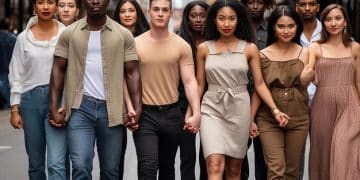Supreme Court 2025: How Rulings Could Reshape Affirmative Action

The Supreme Court’s decisions in 2025 have the potential to significantly alter affirmative action policies nationwide by revisiting precedents, establishing new guidelines, or reinforcing existing restrictions, leading to potential shifts in race-conscious admissions and employment practices.
How Will the Supreme Court’s 2025 Decisions Impact Affirmative Action Policies Nationwide? The ongoing debate surrounding race-conscious policies in education and employment is poised for another chapter. Here’s what you need to know about the potential impact.
Understanding Affirmative Action and Its History in the US
Affirmative action policies have a long and complex history in the United States. From their initial intention to address historical discrimination to the present-day legal challenges, it’s crucial to understand the basic tenets of these policies.
Affirmative action refers to a set of policies and practices designed to address past and present discrimination against groups based on race, ethnicity, gender, religion, or national origin. These policies aim to promote equal opportunity in areas such as education, employment, and government contracting.
Key Milestones in Affirmative Action History:
The roots of affirmative action can be traced back to the Civil Rights Movement of the 1960s.
- Executive Order 10925 (1961): Issued by President John F. Kennedy, this order required government contractors to take affirmative action to ensure that applicants were employed without regard to their race, creed, color, or national origin.
- Civil Rights Act of 1964: Title VII of this act prohibited employment discrimination based on race, color, religion, sex, or national origin.
- Griggs v. Duke Power Co. (1971): The Supreme Court ruled that employment practices that appear neutral but have a discriminatory impact are unlawful.
The legal landscape surrounding affirmative action has been shaped by numerous Supreme Court cases.
- Regents of the University of California v. Bakke (1978): The Court ruled that while affirmative action is permissible, specific quotas are not. Race could be considered as one factor among many in admissions decisions.
- Gratz v. Bollinger (2003): The Court struck down the University of Michigan’s undergraduate admissions policy, which assigned a specific number of points to applicants based on race.
- Grutter v. Bollinger (2003): The Court upheld the University of Michigan Law School’s admissions policy, which considered race as one factor to achieve a diverse student body.
In conclusion, understanding the history of affirmative action provides a critical framework for evaluating its current status and future prospects in light of potential Supreme Court decisions.
The Current Legal Landscape of Affirmative Action
The legal underpinnings of affirmative action are constantly evolving. Recent Supreme Court rulings and ongoing legal challenges highlight the complexity and controversy surrounding these policies and emphasize the need for clarity moving forward.
Currently, the Supreme Court’s stance on affirmative action is largely defined by the rulings in *Gratz v. Bollinger* and *Grutter v. Bollinger* (2003), which set parameters for how race could be considered in college admissions. However, this precedent is always subject to re-examination. Additionally, several states have banned affirmative action in public education and employment through legislation or ballot initiatives.
Major Legal Precedents:
Several key legal precedents frame the current affirmative action framework.
- *Regents of the University of California v. Bakke* (1978): This case established the principle that while race could be a factor in admissions, quotas were unconstitutional.
- *Grutter v. Bollinger* (2003): The Supreme Court allowed the University of Michigan Law School to consider race as one factor among many, aiming to achieve a diverse student body.
- *Fisher v. University of Texas* (2016): The Court upheld the University of Texas at Austin’s affirmative action policy, reiterating that such policies must be narrowly tailored.
These cases highlight the ongoing tension between the goal of promoting diversity and the constitutional guarantee of equal protection under the law.

In conclusion, staying informed about the existing legal framework requires continuous monitoring of court decisions, legislative actions, and public discourse to fully grasp the evolving dynamics of affirmative action.
Potential Scenarios for the Supreme Court’s 2025 Decisions
The Supreme Court’s upcoming decisions in 2025 could significantly reshape the trajectory of affirmative action, and the anticipated outcomes present a range of possibilities, from upholding existing precedents to implementing more stringent restrictions.
Scenario 1: Upholding Existing Precedents: If the Court chooses to uphold *Grutter v. Bollinger* (2003) and *Fisher v. University of Texas* (2016), race can remain one factor among many in admissions decisions. This approach supports the importance of diversity in higher education while still adhering to the principle of equal protection.
Scenario 2: Establishing New Restrictions: The Court could introduce stricter standards for affirmative action policies, potentially requiring universities to demonstrate a compelling interest in diversity that cannot be achieved through race-neutral methods. This might lead to a more limited use of race in admissions processes.
Scenario 3: Overturning Existing Precedents: The most drastic outcome would involve overturning key precedents like *Grutter v. Bollinger*. This would effectively ban the consideration of race in admissions decisions, potentially leading to a significant decrease in racial diversity in higher education.
In conclusion, each of these scenarios carries profound implications for educational institutions and the broader pursuit of equality and diversity.
The Impact on College and University Admissions
The ripple effects of any Supreme Court decision can extend far beyond legal theory, significantly impacting the practical realities of college and university admissions processes. Universities could dramatically alter their strategies for building diverse student bodies based on the court’s directives.
If affirmative action policies are restricted or eliminated, colleges may need to increase their reliance on race-neutral strategies, such as expanding outreach to underserved communities, guaranteeing admission to top students from all high schools, and placing more emphasis on socioeconomic factors.
Strategies Universities Might Implement:
- Targeted Recruitment: Engaging with high schools and community organizations that serve underrepresented minority students.
- Expanded Financial Aid: Providing more financial assistance to low-income students, who are often from underrepresented backgrounds.
- Holistic Review: Adopting a more comprehensive evaluation process that considers a range of factors beyond academic achievement, such as leadership skills, community involvement, and personal experiences.

In conclusion, the future of college and university admissions will likely depend on how institutions adapt to evolving legal standards and their commitment to fostering diverse and inclusive learning environments.
Effects on Employment Practices and Workplace Diversity Initiatives
Beyond education, affirmative action policies influence workplace diversity initiatives, and any changes to these policies could transform the landscape of employment practices and workplace inclusion. These implications span various sectors and industries.
If the Court restricts or prohibits affirmative action, employers may need to reassess their diversity and inclusion programs to ensure compliance with the new legal standards. Companies might shift their focus to race-neutral strategies, such as targeted recruitment, diversity training, and mentorship programs.
Workplace Strategies for Diversity:
- Diversity Training: Educating employees about unconscious biases and promoting inclusive behavior.
- Mentorship Programs: Pairing employees from underrepresented groups with senior leaders for guidance and support.
- Inclusive Recruitment: Implementing strategies to attract a diverse pool of candidates, such as advertising job openings in diverse media outlets and partnering with organizations that serve underrepresented communities.
In conclusion, the effects of the Supreme Court’s decisions will influence the development and refinement of workplace diversity initiatives aimed at fostering more inclusive and representative work environments.
The Broader Societal Implications and Potential Reactions
The societal implications of the Supreme Court’s rulings on affirmative action extend far beyond the immediate impacts on education and employment, touching upon fundamental issues of equality, opportunity, and social justice. Understanding these wider effects is essential for anticipating potential reactions and shaping future policy responses.
A ruling that restricts or eliminates affirmative action could reignite the debate over systemic inequality and the role of race in American society. Supporters of affirmative action have expressed concerns that such a decision could reverse decades of progress in promoting diversity and inclusion, while some argue that race-neutral policies are a more equitable approach.
In conclusion, understanding these diverse perspectives is essential for navigating the complex and emotional landscape surrounding affirmative action.
| Key Aspect | Brief Description |
|---|---|
| ⚖️ Legal Scenarios | Upholding, restricting, or overturning affirmative action precedents. |
| 🎓 Admissions Impact | Universities may adopt race-neutral strategies or face diversity declines. |
| 🏢 Workplace Diversity | Employers may reassess diversity programs to comply with new standards. |
| 🌍 Societal Reactions | Renewed debates, policy shifts, and varied public responses expected. |
Frequently Asked Questions
▼
Affirmative action refers to policies designed to address historical and current discrimination by providing equal opportunities in education and employment, regardless of race, gender, or origin.
▼
The Supreme Court is revisiting affirmative action due to ongoing legal challenges and differing interpretations of the Equal Protection Clause of the Fourteenth Amendment.
▼
Race-neutral strategies are policies that aim to promote diversity without explicitly considering race, such as expanding outreach and focusing on socioeconomic factors.
▼
Without affirmative action, workplaces may need to implement various diversity and inclusion programs, such as bias training and mentorship, to promote inclusivity.
▼
The potential societal impact includes renewed debates on equality, shifts in diversity representation, and policy adjustments to ensure fairness and equal opportunity for all.
Conclusion
The Supreme Court’s forthcoming decisions on affirmative action in 2025 hold the potential to reshape race and identity issues across the U.S. The outcomes will not only influence college admissions and workplace diversity initiatives but also spark broader societal discussions about equality and opportunity.





